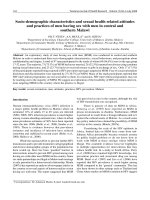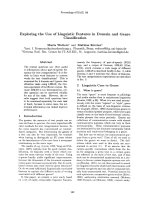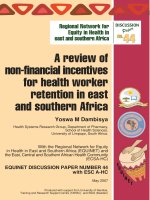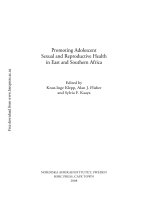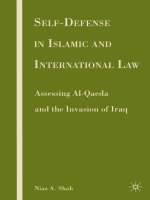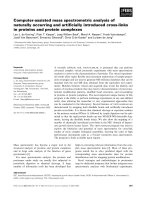Migration in South and Southern Africa potx
Bạn đang xem bản rút gọn của tài liệu. Xem và tải ngay bản đầy đủ của tài liệu tại đây (3.19 MB, 376 trang )
Edited by Pieter Kok, Derik Gelderblom, John O. Oucho & Johan van Zyl
Free download from www.hsrcpress.ac.za
CompiledbytheIntegratedRegionalandRuralDevelopmentResearchProgramme,
HumanSciencesResearchCouncil
PublishedbyHSRCPress
PrivateBagX9182,CapeTown,8000,SouthAfrica
www.hsrcpress.ac.za
©2006HumanSciencesResearchCouncil
Firstpublished2006
Allrightsreserved.Nopartofthisbookmaybereprintedorreproducedorutilisedin
anyformorbyanyelectronic,mechanical,orothermeans,includingphotocopying
andrecording,orinanyinformationstorageorretrievalsystem,withoutpermission
inwritingfromthepublishers.
ISBN0-7969-2113-X
CoverbyFlame
TextdesignbyChristabelHardacre
PrintmanagementbycomPress
DistributedinAfricabyBlueWeaverMarketingandDistribution
POBox30370,Tokai,CapeTown,7966,SouthAfrica
Tel:+27+21701-4477
Fax:+27+21701-7302
email:
Distributedworldwide,exceptAfrica,byIndependentPublishersGroup
814NorthFranklinStreet,Chicago,IL60610,USA
www.ipgbook.com
Toorder,calltoll-free:1-800-888-4741
Allotherinquiries,Tel:+1+312-337-0747
Fax:+1+312-337-5985
email:
Free download from www.hsrcpress.ac.za
Contents
Listoffiguresandtablesv
Frequentlyusedacronymsandabbreviationsix
Chapter1 Introduction
PieterKok,DerikGelderblomandJohanvanZyl1
PARTI: Thecontextofmigrationfromacontinentalandregionalperspective
Chapter2 InternalandinternationalmigrationwithinAfrica
AderantiAdepoju26
Chapter3 Cross-bordermigrationandregionalinitiativesin
managingmigrationinsouthernAfrica
JohnO.Oucho47
Chapter4 HistoricalbackgroundtoSouthAfricanmigration
MarieWentzelandKholadiTlabela71
Chapter5 MigrationinSouthAfricaincomparativeperspective
BarbaraA.Anderson97
PARTII: FindingsfromSouthAfricansurveydata
Chapter6 MigrationandhealthinSouthAfrica
NiëlRouxandLouisvanTonder120
Chapter7 Evaluatingthe2001–02HSRCMigrationSurvey
JohanvanZyl147
Chapter8 ContemporarySouthAfricanmigrationpatternsandintentions
MarieWentzel,JohanViljoenandPieterKok171
Chapter9 Migrantmotivationsandcapacitiesinrelationtokeymigrationstreams
CatherineCross205
Chapter10 Thelimitsandpossibilitiesofmigrantnetworks
DerikGelderblomandWhynieAdams227
Chapter11 MigrationintentionsinSouthAfricaandelsewhere
GordonF.DeJongandMicheleSteinmetz249
Free download from www.hsrcpress.ac.za
PARTIII:Atheoreticalsynthesis
Chapter12 Towardsasyntheticmodelofmigration
DerikGelderblom268
APPENDICES
AppendixA ThehistoryandmethodologyoftheHSRCsurveys
PieterKok,JohanvanZylandJacquesPietersen292
AppendixB GISasatoolinmigrationresearch
GinaWeir-SmithandS’bonisileZama307
AppendixC Applyingthemultiregionalprojectionmodelusingcensusmigrationdata:
atheoreticalbasis
JacquesLedentandSulaimanBah327
AppendixD Provinciallevelsofsatisfactionwithservicedelivery:
ananalyticalframeworkbasedoninterprovincialmigration
OumarBouareandJohannaNkau343
Abouttheauthors355
Index359
Free download from www.hsrcpress.ac.za
v
Listoffiguresandtables
Figures
Figure1.1Theworld’sforeign-bornpopulation2
Figure1.2Globalnetmigrationpatterns3
Figure1.3Specificpoliciesonimmigration4
Figure1.4Somespecificpoliciesonemigration5
Figure1.5Theworld:urbanandruralpopulations(actualandprojected)11
Figure1.6TrendsinurbanisationlevelsofselectedsouthernAfricancountries(actualand
projected)11
Figure1.7Governmentpoliciesoninternalmigrationintometropolitanareasinthemore
developedregionsoftheworld12
Figure1.8Governmentpoliciesoninternalmigrationintometropolitanareasinthe
less
developedregionsoftheworld13
Figure3.1AveragenumberofpeopleemployedonSouthAfricanminesbycountryoforigin,
1986–199258
Figure5.1Comparativegrowthratesper1000population103
Figure5.2Estimatednetmigrationratesper1000population103
Figure5.3Legalimmigration,emigrationandnetmigrationratesforSouthAfrica
per1000population104
Figure5.4NetmigrantstoSouthAfrica,fromresidualmethodandfromofficialdata105
Figure5.5Percentageofpopulationsinurbanareas108
Figure5.6Growthratesofurbanpopulations(per1000population)109
Figure5.7Estimatedratesofnetrural–urbanmigrations(per1000population)110
Figure5.8PercentagesofAfricansandofnon-Africansinurbanareas111
Figure5.9LivingsconditionsforvariousSouthAfricangroupsin1994and1999112
FigureB1Intra-provincialmigrationintheEasternCape,2001308
FigureB2Intra-provincialmigrationmovementstowardstheCapemagisterialdistrict,2001310
FigureB3Intra-provincialmigrationtoGauteng,2001311
FigureB4MigrantstoGautengbyprovinceoforigin,2001312
FigureB5Comparisonofemploymentandunemploymentin1996and2001312
FigureB6Inter-provincialmigrationtoKwaZulu-Natal,2001313
FigureB7Inter-provincialmigrationtotheWesternCape,2001314
FigureB8MigrantstoWesternCapebyprovinceoforigin,2001314
FigureB9Inter-provincialmigrationtoGauteng,KwaZulu-NatalandWesternCape,2001315
Free download from www.hsrcpress.ac.za
vi
FigureB10Comparinginter-provincialmigrationinGauteng,2001316
FigureB11Copyingfeaturesfromonelayertoanother318
FigureB12Exampleofanorigintablewithallthecalculatedfields319
FigureB13Exampleofaflowtable320
FigureB14Exampleofdatadirectories321
FigureB15ExampleofopeningfilesinFlowmap321
FigureB16PeopleflowsfromselectedmagisterialdistrictstoEastLondon,2001322
FigureB17Redrawingorerasingthescreen323
FigureB18MigrationflowsfromselectedmagisterialdistrictstoEastLondon,2001324
Tables
Table1.1SelectedsouthernAfricancountries’immigrantpopulations
(internationalmigrantstock)9
Table1.2IndicatorsofspatialpopulationdistributionforselectedsouthernAfricancountries9
Table3.1TypologyofcurrentinternationalmigrationinsouthernAfrica,
bytypicalcharacteristicsandcountryoforigin/destination50
Table3.2Totalpopulation,migrantstockandemigrationandmigrationpoliciesin
southernAfricancountries1990–200053
Table3.3SampleofimmigrantstoSouthAfricabycountryoforiginandcountry
ofpreviousresidence(weightedpopulationfigures)54
Table3.4EmploymentonSouthAfricangoldminesbycountryoforigin1986–1992
58
Table3.5RefugeesandasylumseekersinsouthernAfricabyoriginandhostcountry,200161
Table4.1NumbersofAfricansinurbanareasbetween1914and1960
84
Table6.1Healthoutcomesasconsideredbymigrationphase
122
Table6.2Frequencydistributionofrespondentsbymigrationstatusand
selectedsocio-demographiccharacteristics127
Table6.3Self-ratedhealthstatus
128
Table6.4Percentagesindicatingknowledgeofhavingcontractedspecificdiseases
129
Table6.5Primaryreasonformovetocurrentplaceofresidence
130
Table6.6Pre-migrationknowledgeofhealthandpublicservices,
bysocio-demographiccharacteristics131
Table6.7Migrantsindicatingimprovementinspecifichealthindicators
133
Table6.8Percentageofmigrantsindicatingsicknessbeforeandaftermoving
135
Table6.9Logisticregressionanalysisforself-ratingofhealth136
Table6.10Logisticregressionanalysisforknowledgeofhealthandpublicservices
beforepreviousmove138
Free download from www.hsrcpress.ac.za
vii
Table6.11Logisticregressionanalysisforspecifichealthindicators139
Table7.1HSRCMigrationSurvey:totalnon-responseratesbypopulationgroup
148
Table7.2HSRCMigration
Survey:itemnon-responseformonthlyincome148
Table8.1Cross-bordermigrantsbycountryoforigin(lastmoveonly)
175
Table8.2Employmentstatusofvariousmigrantcategories
176
Table8.3Reasonsfornotworking,bymigrantcategory
176
Table8.4Occupationalstatus,byrespondentgroup
177
Table8.5Migrants’monthlyincome,bymigranttype
178
Table8.6Cross-bordermigrants’lengthofstayincurrentarea178
Table8.7Cross–bordermigrants’reasonsforleavingpreviousareaofresidence
179
Table8.8Mainreasonsformoving,bymigrantgrouping
180
Table8.9Cross-bordermigrants’reasonsforselectingdestinationarea
181
Table8.10Cross-bordermigrants’priorknowledgeofdestinationarea
181
Table8.11Cross-bordermigrants’informationsourcesondestinationarea182
Table8.12Cross-bordermigrantdecisionmakersformovetocurrentarea
182
Table8.13Levelofsatisfactionwithpresentcircumstances,byrespondentgroup
183
Table8.14Internalmigrants’provinceoforigin(beforelastmove)
185
Table8.15Employmentstatusofvariousmigrantcategories
185
Table8.16Reasonsfornotworking,bymigrantcategory185
Table8.17Distributionofoccupationalstatus,byrespondentgroup
186
Table8.18Distributionofrespondents’monthlyincome
187
Table8.19Internalmigrants’periodofstayincurrentarea
187
Table8.20Internalmigrants’reasonsforleavingpreviousarea
188
Table8.21Internalmigrants’reasonsforselectingdestinationarea
188
Table8.22Respondents’mainreasonsformoving
189
Table8.23Internalmigrants’priorknowledgeofdestinationarea190
Table8.24Internalmigrants’informationsourcesregardingdestinationarea
190
Table8.25Internalmigrantdecisionmakersformovetocurrentarea
190
Table8.26Satisfactionlevelsregardingpresentcircumstances,byrespondenttype
191
Table8.27Currentprovinceandpossibledestinationinnextfiveyears
193
Table8.28‘Verylikely’interprovincial/internationalmigrationinnextfiveyears
194
Table8.29StatisticaldetailsofexplanatoryvariablesusedintheMNA
195
Table8.30Migrationintentions,byagegroup196
Table8.31Migrationintentions,bycurrentmaritalstatus
196
Free download from www.hsrcpress.ac.za
viii
Table8.32Migrationintentions,byeducation197
Table8.33Migrationintentions,bylifesatisfaction
197
Table8.34Migrationintentions,byexistenceornotofmigrantnetwork
198
Table8.35Migrationintentions,byvalue-expectancyfor‘urbanenvironment’
198
Table8.36Migrationintentions,byvalue-expectancyfor‘wealthandcomfort’
198
Table8.37Migrationintentions,byvalue-expectancyfor‘affiliationandmorality’
199
Table9.1ScaleofmigrationactivityinSouthAfrica,byAfricanpopulation
208
Table9.2Yearofmovetoareaofinterview
209
Table9.3Proportionsoflifetimeflowtakingplaceviamajorstreams210
Table9.4Typeofareawhereborn,bymigrationstream
213
Table9.5Previousresidenceareatype,bymigrationstream
214
Table9.6Reasonsforleavinglaststoparea,bymigrationstream
215
Table9.7Reasonsforchoosingtomovetocurrentarea
216
Table9.8Capacities:demographicandeconomicfactors218
Table9.9Economicactivity,landaccessandlabourmigrancy
219
Table10.1Comparisonbetweenmarketandnetworkexchange
229
Table10.2Immediatefamilyorclosefriendsatdestination
242
Table10.3Immediatefamilyorclosefriendsatdestination,byincomeandgender
242
Table10.4Previousmigrations:mainsourceofinformationaboutdestination243
Table10.5Intendedmigrations:mainsourceofinformationaboutdestination
243
Table10.6Previousmigrations:mainsourceofinformation
243
Table10.7Intendedmigrations:mainsourceofinformation
243
Table10.8Respondents’networkconnectionsinpreviousandcurrentlocations244
Table11.1Ruralandurbanresidents’intentionstomigrate
253
Table11.2Intentionstomigrate,byselectedindividualandhousehold
254
Table11.3Logisticregressionofintentionstomigrate:totalsample258
Table11.4Logisticregressionofintentionstomigrate:ruralandurbansamples
262
TableA1Realisationresultsbysurveycompany
303
TableA2Realisationresultsintermsoforiginalstratification
303
TableB1Filestructureexample
318
TableB2
Exampleofaflowtable319
TableD1Questionnaireitemtobeusedthroughouttheprovincesofacountry
346
TableD2Exampleofproportionaldistributionofrespondentcategories
347
Free download from www.hsrcpress.ac.za
ix
Frequentlyusedacronymsandabbreviations
BBC BritishBroadcastingCorporation
CENPOPS CentreforPopulationStudies(UniversityofPretoria)
COMESA CommonMarketforEasternandSouthernAfrica
DBSA DevelopmentBankofSouthernAfrica
EA enumeratorarea
GIS geographicalinformationsystem(s)
GNP grossnationalproduct
HSRC HumanSciencesResearchCouncil(SouthAfrica)
ILO InternationalLabourOffice(UN)
IMP InternationalMigrationPolicy
IOM InternationalOrganizationforMigration
LDRs less-developedregions(oftheworld)
MDRs more-developedregions(oftheworld)
MIDA MigrationforDevelopmentinAfrica
MIDSA MigrationDialogueforSouthernAfrica
MNA multivariatenominal-scaleanalysis
MPI MigrationPolicyInstitute
NRC NativeRecruitingCorporation
NEPAD NewPartnershipforAfrica’sDevelopment
OHS OctoberHouseholdSurvey
PRB PopulationReferenceBureau(USA)
SADC SouthernAfricanDevelopmentCommunity
SADCC SouthernAfricanDevelopmentCoordinationConference
SAMHS SouthAfricanMigrationandHealthSurvey
SAMP SouthernAfricanMigrationProject
SANSA SouthAfricanNetworkofSkillsAbroad
SDI SpatialDevelopmentInitiative
StatsSA StatisticsSouthAfrica
UN UnitedNations
UNDP UnitedNationsDevelopmentProgram
UNECA UnitedNationsEconomicCommissionforAfrica
Free download from www.hsrcpress.ac.za
x
UNFPA UnitedNationsPopulationFund
UNHCR UnitedNationsHighCommissionerforRefugees
Unisa UniversityofSouthAfrica
WHO WorldHealthOrganization(UN)
WNLA WitwatersrandNativeLabourAssociation(Wenela)
ZAR ZuidAfrikaanscheRepubliek
Free download from www.hsrcpress.ac.za
introduction
•
1
CHAPTER1
Introduction
PieterKok,DerikGelderblomandJohanvanZyl
Thetenthanniversaryofthe1994firstdemocraticelectionsinSouthAfricawas
anopportunetimetoreflectonwhathad–andwhathadnot–changedinthe
countrysincetheendofapartheid.GrandApartheidhadattemptedtoalterthe
racialdistributionofthepopulationthroughmechanismssuchasan‘influxcontrol’
system,populationrelocationandthecreationofrelativelydensesettlementsinthe
formerhomelandareas.Assuchithadanimportantimpactonpatternsofinternal
migration.Inaddition,becausethepermanentsettlementofblackpeoplefrom
AfricancountriesnorthofSouthAfricanborderswasnotallowed,apartheidalso
changedpatternsofinternationalmigration.Oneofthethingsweneedtoascertain
thereforeishowmuchtheliftingofapartheidhasaffectedmigrationpatterns,both
internallyandinthesouthernAfricanregion.
Thistaskimplies,firstly,thatsomepurelydescriptiveresearchonbothcurrentand
pastmigrationpatternsinSouthAfricaneedstobeundertaken,investigatinghow
muchmigrationoccurredduringtheapartheidperiodandafterit.Inaddition,it
stillneedstobedeterminedwhetherthemigrationwaspredominantlyrural–urban
orrural–rural.Alsotobeconsiderediswhetheratypologythataccountsforthe
areasbetweenruralandurbanwouldnotbemoreappropriateinthedescription
ofmigrationpatterns–forexampleonegradingfromrural,throughsemi-urban,
peri-urban,andurbanareastofullymetropolitan.Agreaterunderstandingofthe
historicalcontextofmigrationinSouthAfricaisthusneeded,toachieveamore
nuancedviewofthecontinuitiesanddiscontinuitiesinSouthAfricanmigration
overtime.
Migrationissuesandimplicationsforpolicy
Inthisbook,whichdealslargelywiththecausesofmigration,weattempttoanalyse
andevaluatebothinternationalandinternalmigrationinSouthandsouthernAfrica.
Althoughitspolicyandplanningimplicationsarenotalwaysobvious,inmostcases
theindividualchaptersbringtheissuesinvolvedclearlytothefore.Perhapsabroad-
brushreminderoftheseissueswouldbeappropriatehere.
Internationalmigration
Storiesaboutforeignmigrants–legal,illegalandasylumseekers–appearalmost
dailyinthenews.Governments…notetheseeventswithalarmandgrapplewith
policyreformsaimedatselectingcertainmigrantsandkeepingoutothers.(Hatton
&Williamson2002:1)
ThisquotationfromHattonandWilliamsonisausefulsummaryoftheimpactthat
internationalmigrationoftenhasonpublicperceptionsandhenceonlegislated
Free download from www.hsrcpress.ac.za
2
•
migrationinsouthandsouthernafrica
migrationpolicy.Thereseemstobewidespreadagreementthatglobalisation–
whichisusuallyinterpretedtomeanthemobilityofgoodsandfactorsofproduction
(suchaslabour,capitalandinformation)acrossinternationalborders–hasbeen
ontherisesincetheSecondWorldWarandhascurrentlyreachedunprecedented
heights.Despitethetightconstraintsoftoughimmigrationpoliciesthatalmost
certainlysuppressedavastamountofpotentialmovementofpeople(Hatton&
Williamson2002),worldmigrationhasneverthelessincreasedrapidlyduring
recentyears.
Figure1.1,obtainedfromBBCOnline(2004),andbasedondatageneratedbythe
InternationalOrganizationforMigration(IOM),showsthatin1965therewere
anestimated75millionmigrants(thatis,peopleborninacountryotherthanthe
oneinwhichtheywereresidingin1965),representingtwopercentoftheworld
population.By2002thisnumberhadgrownto175million(almostthreepercent
ofthepopulation),givinganaverageannualgrowthrateinthe‘foreign-born’
populationof2.3percent–ascomparedwiththeaverageannualgrowthof
1.8percentinthetotalworldpopulation.
SanderandMaimbo(2003:10)confirmthesefigures:
Worldwide,one of every 35 people,an estimated 175 million, live outside their
countryoforigin,upfrom75millionin1965.Migrationisprojectedtogrowatan
annualrateof2to3percent.
Themonotonicandrapidincreaseinthemigrantpopulationhasbeenacause
forconcerninmostcountries.Thegovernmentsof‘netreceiving’countriesare
concerned,amongotherthings,aboutthenumberofwork-seekersaddedannuallyto
theiralreadynearlysaturatedlabourmarkets,whilethegovernmentsof‘netsending’
countriestendtobeconcernedmainlyaboutthelossofskills(the‘braindrain’).
Figure1.1Theworld’sforeign-bornpopulation
Source:BBCOnline2004
Free download from www.hsrcpress.ac.za
introduction
•
3
Figure1.2,alsoobtainedfromBBCOnline(2004)andbasedondatagenerated
bytheUnitedNations,showsthenetmigrationflowsbetweencountriesduring
theperiod1995–2000.Whileitisclearthatmostindustrialisedcountrieswerenet
receiversofinternationalmigrantsinthatperiod,somedevelopingcountries(such
asArgentinainSouthAmerica,andChadinAfrica)alsoreceivedmoreimmigrants
thanthenumberofemigrantsthattheylost.
1
InAfrica,theDemocraticRepublicoftheCongohadthegreatestnetlossof
migrants,inabsoluteterms,duringtheperiod1995–2000.AlthoughSouthAfrica
alsoexperiencedanetemigration,itwasamuchlowerpercentageofthecountry’s
totalpopulation.
Africaisbyfartheworld’spoorestcontinent,butithasgeneratedremarkablyfew
migrantstotheindustrialcountries,despitethemassivegainsthatthiswouldseem
likelytobringtosuchmigrants.
True,migration pressure, as reflected by illegal flows between North Africa and
southernEurope,hasoftenhittheheadlines.Also,theshareofAfricansinlegal
immigration to the US has increased.Yet,real incomes in Africa are but a tiny
fractionofthoseinEuropeandNorthAmericasotheincentivetoemigrateshould
behuge.Indeed,thegapsaremanytimeslargerthanthosethatgaverisetothemass
emigrationsfromEuropeacenturyago.(Hatton&Williamson2002:17)
Thisapparentparadoxcanbeexplainedlargelybythefactthatthepoorestpeople
havetoovercomeconsiderableobstaclestotheirpotentialmigration(seeGelderblom
inChapter12ofthisvolume).Alsoveryimportantaretheimmigrationpolicies
Figure1.2
Globalnetmigrationpatterns
Source:UnitedNations2002
Free download from www.hsrcpress.ac.za
4
•
migrationinsouthandsouthernafrica
ofindustrialcountries,whichstressfamilyreunificationorskills.Theseimpose
hugebarrierstopotentialAfricanmigrantswhowouldotherwisehavemoved
totheindustrialcountries,inresponsetothelargeincomedifference(Hatton
&Williamson2002).Initslatestreportonglobalisation,theUnitedNations
InternationalLabourOffice(ILO2004)confirmsandgeneralisestheseconclusions.
Itshouldbenotedthatastrongpolarisationofviewsexistsregardingthedesirability
ofextendingopportunitiesforinternationalmigration.Whilemigrationdoes
haveconsiderablepotentialbenefits–bothforthemigrantsthemselvesandfor
theircountriesoforiginanddestination–itshouldberecognisedthatthereare
also‘potentialcostssuchasthedisplacementoflocalworkers,thedisruptionof
labourmarketinstitutionsandsocialprotectionsystems,andtheweakeningof
socialcohesion’(ILO2004:97).AstheILOcorrectlypointsout,‘therearecostsand
benefitsinvolvedthatshouldbeseriouslyweighed’(2004:97).
2
Intheremainderofthissectionattentionisgiventopolicyresponsesandtothe
implicationsofsomeofthemainformsofinternationalmigration.Initsrecent
studyonpopulationpolicies,theUnitedNations(2004)shows,onacountry-by-
countrybasis,theevolutionofgovernmentviewsandpolicies(from1976to2003,
wheredataareavailable)withrespecttoissuessuchaspopulationsizeandgrowth,
populationagestructure,spatialdistributionandinternationalmigration,within
thecontextofdemographic,socialandeconomicchange.Thereportstatesthat
levelsofimmigrationwereregardedas‘unsatisfactory’inonlyasmallproportionof
developingcountries,butagreaterproportionofindustrialcountriesviewedthem
asproblematic,thatisbeingeithertoohigh(23%)ortoolow(10%).Onlyfour
percentofthemoredevelopedcountriesdidnotimplementsomeformofpolicy
interventionwithaviewtochangingtheselevels.Theissuesthatgovernmentsof
industrialcountrieshadwithimmigrationin2003tendedtofocusonpreventing
undocumentedentryandotherformsofillegalimmigration(seeFigure1.3).
Figure1.3Specificpoliciesonimmigration
Source:CalculatedfromUnitedNations2003
Free download from www.hsrcpress.ac.za
introduction
•
5
Figure1.4Specificpoliciesonemigration
Source:CalculatedfromUnitedNations2003
Figure1.4showsthe2003distributionoftwopolicyresponsestoemigrationissues.
Concernswithhighlevelsofemigrationamongtheindustrialcountriesarefound
mostlyamongEasternEuropeancountries(UnitedNations2003).
In…Africa,AsiaandLatinAmericaandtheCaribbean,concernswithhighemi-
grationeasedduringthe secondhalf of the1990sandthe beginningof the 21st
century.Thismay,inpart,reflectthegrowingrecognitionoftheimportanceofwor-
kers’remittancesfortheeconomiesofsendingcountries.(UnitedNations2003:15)
Typesofinternationalmigration
Threemaintypesofinternationalmigrationareusuallyidentified,namely
labourmobility,refugeemovements,andmorepermanentmigration.Theseare
summarisedinthesectionsbelow.Undocumentedorillegalmigrationisasubsetof
eachofthesemigrationforms,andwillbetoucheduponseparately.
Labourmobility
Inausefulandprovocativeevaluationofthebenefitsanddisadvantagesoflabour
migration,Ellerman(2003:15)pointsoutthatalthoughlabourmigrantsareoften
unskilledtheyoften‘havesomeconsiderableentrepreneurialdrivetowardsself-
betterment(ofwhichthelabourmigrationistestimony),somecomplementofskills,
andsomeresourcesinordertofinancethetriportrips’.Sendingcountriestherefore
tendtoloseanimportantpartoftheirhumancapitalinaprocessfrequentlyreferred
toasthe‘braindrain’.Labourmigration,furthermore,tendstobecumulative:
‘Remittancesmayleadtomoremigrationbecausetheyshowthatmigrationworks,
theyfinanceotherfamilymembers’trips,andtheyshowwhattheneighborshaveto
doto“keepupwiththeJoneses”’(Ellerman2003:15–16).
Remittancesfrommigrantsaresosignificantthattheyoutweightheinternational
developmentaidflowingintodevelopingcountries.‘Thereismuchconcernabout
thedevelopmentalimpactofaidtransfersfromtheNorthtotheSouth,andyet,on
thewhole,remittancesareevenlargerthanallaidtransfers’(Ellerman2003:18).
Free download from www.hsrcpress.ac.za
6
•
migrationinsouthandsouthernafrica
Ellermanconcludesthat‘thepotentialdevelopmentalroleofremittancesshouldbe
animportanttopicforpolicyresearchandexperimentation’(2003:18).
‘Labour’or‘work’migrantsconstituteamajorityofallmigrants,butitshouldbe
notedthatthedebateonwhetherornottemporaryworkmigrationisgenerally
beneficialhasyettobeconcluded.
TheILO’sstudy(2004)highlightsthewidespreadbenefitsoflabourmigration,not
onlyforsendingcountriesbutalsoforthecountriesreceivinglabourmigrants:
Mostindustrialisedcountrieshaveageingpopulationsthataretendingtodecline,
whilemostdevelopingcountrieshaveyoungandgrowingpopulations.Manyof
theproblemsof an ageingpopulation,suchasadeclininglabour forceandthe
difficulties of financing social security in the face of rising dependency ratios,
couldbeattenuatedbyincreasedimmigrationontermswhichrespecttherights
of migrant workers. More generally, global labour productivity would increase
throughthisprocesssincethemigrationwouldbefromlow-productivity,surplus-
labour countries to higher-productivity ones. This would benefit not only the
individualmigrantsinvolvedbutalsotheirhomecountriesthroughremittances,
aswellasthetransferofskillsandthestimulusgiventobusinessactivitybythe
diaspora.(ILO2004:96)
However,notalleconomistssharetheaboveoptimismaboutthebenefitsoflabour
migration:
There is general agreement among observers that by itself labour migration is
unlikelytosignificantlyimprovethedevelopmentpotentialofasendingcountry.
Whileindividualmigrantsandtheirfamiliestendtogainfrommigration(interms
ofgreatereconomicsecurity),thesamecannotbe claimed for the countries,as
a whole. Thereis little evidence to indicate that labour migration and flows of
remittanceshavegeneratedsustainedgrowth.(Abella,quotedinEllerman2003:
24)
Thecontroversydoesnotendthere,though:
Thereisnothingmorepermanentthan‘temporary’migration.
Thisquipisprobablyindicativeofthemanynegativeperceptionssurrounding
‘temporary’migration,yetthereissometruthinit.Mostlabourmigrantsfrom
developingcountriesprobablywanttoreturntotheirhomecountrybefore
retirement,possiblytousetheircapitalandknowledgeinthehomecountry,thus
perhapscontributingtoeconomicdevelopmentthere.But,asEllerman(2003)
correctlypointsout,manyfinditdifficulttoreturnhomeoncetheyhavebecome
establishedinthehostcountry.Inothercases,membersofafamilymightmove
awaytofindworkelsewhere,‘notasatemporarymeasuretoacquirecapitalor
knowledge,butasacareerchoicethatwillincreaseanddiversifytheincomeofthe
wholefamily’(Ellerman2003:15).
Free download from www.hsrcpress.ac.za
introduction
•
7
Ellerman(2003:17)arguesthatmigrationisnothingbutasafetyvalvethatrelieves
thepressureofaproblem–suchasunemployment–withoutresolvingtheproblem
itself.Remittancesaresometimesregardedashavingapro-developmentmultiplier
effect(evenifspentnon-productively),buttheycanhavenegativemultipliereffects
intimesofeconomicrecession.Theyalsodonotleadtosustainabledevelopment,
thatis,developmentthatisnotreliantonremittances.Furthermore,remittancesare
largelydrivenbyrecentmigration:‘Asmigrantsspendmoretimeinthehostcountry
andadjust,remittancesfall’(Ellerman2003:22).Therefore,althoughremittances
canjump-startdevelopmenttheyshouldnotbeexpectedto‘supplytheongoingfuel’
(Ellerman2003:24).
SanderandMaimbo(2003:1)indicate,though,thatmoneytransfers:
havefilledagapleftbyinadequatefinancialinfrastructureinAfrica,astructural
weaknessthataffectsnotonlytheflowofremittancesandtheirchannels,butalso
theoptionsforuseandinvestmentofthefunds.Becausefinancialservicestypically
donotreachintotheruralareasofthecontinent,manylow-incomeearnerslack
accesstoformaltransferservices.
Theyalsoshow,asindicatedinBox1.1onpage8,that‘althoughremittances
andrelatedaspectsofmigrationandfinancialservicesaresimilarinsomeways
throughoutthedevelopingworld,sub-SaharanAfricaisinotherrespectsunique’
(Sander&Maimbo2003:1).
Thelastwordonthiscontentiousissuehasthereforenotbeenspoken.Despitethe
controversy,itisclearthatremittancestodevelopingcountriesfromtemporary
internationallabourmigrationnotonlybenefithouseholdsandcountriesatorigin,
theyhavealso‘faroutpacedmigration’sincethebeginningofthe1990’s(cf.Sander
&Maimbo2003:10).Forexample,remittancesareofcrucialeconomicimportance
tomanyAfricanhouseholdsandnations,‘helpingtostabilizeirregularincomesand
tobuildhumanandsocialcapital.Remittancereceiversaretypicallybetteroffthan
theirpeerswholackthissourceofincome.Atthenationallevel,remittanceshavea
substantialeffectonthebalanceofpaymentsandonforeignexchangerevenuesin
Egypt,Lesotho,andothercountries’(SanderandMaimbo2003:1).
Refugeemovements
As is the case with work migrants, asylum seekers are reluctant migrants who
generallywanttoreturnhome.Whentheydo,itisoftentoadevelopingcountry,
frequentlyoneravagedbyconflict.(Nicholson2002:8)
CoercedorforcedmigrationisnotsomethingnewinAfrica.Fromthe17th
tothe19thcenturylargenumbersofslavestravelledacrosstheAtlantictothe
Americas(Hatton&Williamson2002).‘MorerecentlyAfricahasbecomefamous
foritsrefugees.WhileAfricaaccountsforalittlemorethanatenthoftheworlds
population,ittypicallyaccountsformorethanathirdoftheworld’sstockof
refugeeslivinginforeigncountries’(Hatton&Williamson2002:18).
Free download from www.hsrcpress.ac.za
8
•
migrationinsouthandsouthernafrica
Box1.1Uniqueaspectsofremittancesinsub-SaharanAfrica
• Migrationisintraregionalanddomesticaswellasshort-termandseasonal.
• Officiallyrecordedremittanceflowsareartificiallylow,reflectingunder-reportingofflowsthrough
formalchannelsandhighflowsthroughinformalchannels.
• OfficiallyrecordedflowstoAfricahavenotkeptpacewiththosetootherdevelopingregions,despite
growingmigration(intraregionalandinternational).
• Trustininformalremittancechannelsiserodinginsomeareas.
• Demandisgrowingforservicestoaccompanyorreplacetransfersoffunds(forexample,deliveryof
goodstofamiliesbackhome).
• Weakfinancialsystemsprovidelimitedservices,especiallyinruralareas,reducingaccesstofinancial
servicesandproductssuchassavingsaccountsandmortgages.
• Regulationoffinancialservicesisrestrictive.
Source:Sander&Maimbo2003:1
Africanrefugeesareoftenfoundinruralpartsofborderingstateswherethey
experienceevengreaterdeprivationthantheydidathome(Hatton&Williamson
2002:18).InChapter4ofthisbook,WentzelandTlabelapointoutthatthevast
majorityofSouthAfrica’srefugeepopulationisMozambican–asaresultofthecivil
warintheirhomecountryduringthe1980s.ThepreviousSouthAfricangovernment
atfirstrefusedtorecognisetheseMozambicanrefugees,therebydeprivingthem
ofinternationalassistance,whichforcedthousandsofthemtobecome(illegally)
economicallyactiveintheirhostcountry.Itisinthiscontextthatitshouldbe
rememberedthattheskillsandotherbenefitsthatlabourmigrantsbringwhenthey
returnhomeareneededintheirhomecountries.‘Thisisastrongargument(though
noneshouldbeneeded)forallowingrefugeestowork,andtoobtaincapital,skills
andideasfortheirreturn,asworkmigrantsdo’(Nicholson2002).
Morepermanentmigration
Whilelabourmigrationisoftenassociatedwithlowerskilllevels,thosepeople
involvedinmorepermanentmigrationtendmoretohavehigherskillsasaresultof
thegreatereconomicreturntoeducationinindustrialcountries.Thisobservation
takesoneinevitablytotheissueoftheso-calledbraindrain.
ThebraindrainhasbeenregardedasaproblemsincetheSecondWorldWar,
‘cripplingtheactivitiesofsomecountries,forexampleinsub-SaharaAfricaand
particularlyinSouthAfrica’(Ellerman2003:30).Policiesaimedatcurbingthebrain
drainmayhaveside-effectswhicharejusttheoppositeofwhatwasdesired:for
examplelegalrestrictionsonemigrationora‘departuretax’tobepaidbyreceiving
countriestosendingcountries.Suchpoliciesareseennowadaysasarchaicandin
factnotimplementable.Ontheotherhand,certainideas,suchasatransnational
communityofscientistsandengineershelpingboththereceivingandsending
countries,maynowhavebecomemorefeasible,duetoglobalisation.‘Thuswhile
globalisationmightaggravatesomeoldproblems,itmightalsoentrainsome
newsolutions’(Ellerman2003:31).Initiativestoaugmentmutuallybeneficial
‘transnationalcommunities’
3
aboundincountriesthathavesizablediasporassuch
asIndia,China,SouthAfrica,Argentina,Armenia,PakistanandIsrael(Ellerman
2003:34).
Free download from www.hsrcpress.ac.za
introduction
•
9
Undocumentedmigration
Despiteallthenegativethingsbeingsaidaboutillegalmigrants,itshouldbe
appreciatedthat:
the risks they take are indicative of their determination to find work, to help
themselves.Migratingillegallyisawager,whichtheymightlose,buttheyknow
theywilldefinitelyloseiftheydonotmigrate.Itis,indeed,economicrisk-taking,
ifofanunconventionalkind.(Nicholson2002:4)
Internalmigrationandurbanisation
ItwaspointedoutearlierthatthelevelofmigrationfromAfricahasbeen
surprisinglylow,andthiswasascribedtohighpovertylevelsandaconsequentlack
ofmobility.Theevidenceforthisconclusioncanhoweverberegardedassomewhat
ambiguous(see,forexample,Hatton&Williamson2002).Chapter12byDerik
Gelderblomprovidesanexplanationfordifferencesinincomeselectivity:the
thresholdincomewheremigrationbecomesaffordablevariesfromtimetotimeand
fromplacetoplace.Whenthecostsofmigrationarelowrelativetoincomes,income
selectivityisalsolow,andifmigrationcostsarehighrelativetoincomes,income
selectivityishigh.Althoughthepolicyimplicationsofsuchtrendsareclear,itis
notatallclearwhetherorhowdevelopmentpolicyandplanningwouldbeableto
addresstheissueofout-migrationfromruralareasamongthebetterskilled(seealso
Kok,O’Donovan,Bouare&VanZyl2003).
Recurrentchangesinviewsonmigration-relatedproblemswerereportedby
theUnitedNations(2003)forthegovernmentsofSouthAfricaandfourofits
immediateneighbours.Tables1.1and1.2,basedonthesedata,givethecontextfor
theseviewsintermsoftheunderlyingmagnitudesforthereportedyearsfrom1976
to2003.
Table1.1(basedonUnitedNations2003figures)showstheestimatednumbersand
proportionsofformerimmigrantswithrespecttofiveselectedsouthernAfrican
countries.TheestimatedinternationalmigrantstockinNamibiaincreasedfrom
42000(4.5%)in1976to143000(7.5%)in2003.ThesameappliestoBotswana,
whoseforeign-bornpopulationalsogrewconsistentlyfrom13000(1.6%)in1976
to52000(3.0%)in2003.Ontheotherhand,SouthAfrica,whichaccommodates
byfarthelargestestimatednumberofimmigrantsinthesub-region,hasseena
proportionaldecreaseinthesenumbersfrom5.5percentin1986toasignificantly
lower3.0percentin2003.
Whereas39percentofAfrica’stotalpopulationlivedinurbanareasin2003,by
2030thecontinent’surbanareasarelikelytoaccommodatethemajority(54%)of
itspeople(UnitedNations2004).Asfarasinternalpopulationredistributionin
thesub-regionisconcerned,Table1.2(alsobasedonUnitedNations2003figures)
showsthattheruralpopulationsofBotswana,LesothoandSouthAfricaare
purportedtobecurrentlyexperiencingnegativegrowth,whileBotswana,Lesotho
andSwazilandexperiencedrapidurbanisationbetween1976and2003.Botswana
wasparticularlyaffectedbyurbanisationprocesses,withthelevelofurbanisation
increasingfrom13percentin1976to50percentin2003.
4
Free download from www.hsrcpress.ac.za
10
•
migrationinsouthandsouthernafrica
Table1.1SelectedsouthernAfricancountries’immigrantpopulations
(internationalmigrantstock)
Botswana Lesotho Namibia SouthAfrica Swaziland
1976
Percentageoftotalpopulation
1.6 0.4 4.5 3.7 5.4
Number 13000 4000 42000 962000 28000
1986
Percentageoftotalpopulation
1.7 1.1 7.4 5.5 5.8
Number 20000 16000 84000 1815000 41000
1996
Percentageoftotalpopulation
2.4 0.3 7.5 3.3 4.0
Number 38000 5000 124000 1353000 38000
2003
Percentageoftotalpopulation
3.0 0.3 7.5 3.0 4.0
Number 52000 6000 143000 1303000 42000
Source:UnitedNations2003
Table1.2IndicatorsofspatialpopulationdistributionforselectedsouthernAfricancountries
Botswana Lesotho Namibia SouthAfrica Swaziland
1976
Annualruralpopulationgrowth(%)
2.5 1.6 2.2 2.5 1.8
Annualurbanpopulationgrowth(%)
12.6 6.7 4.8 2.7 10.1
Populationdensity(peoplepersqkm)
1 38 1 21 30
Urbanpopulationproportion(%) 13 11 21 48 14
2003
Annualruralpopulationgrowth(%) -0.3 -0.4
0.9 -1.1 0.4
Annualurbanpopulationgrowth(%)
1.4 3.4 3.3 2.1 2.2
Populationdensity(peoplepersqkm)
3 59 2 37 62
Urbanpopulationproportion(%)
50 30 32 59 27
Source:UnitedNations2003
Asfarasurbanisationisconcerned,Figure1.5,obtainedfromthePopulation
ReferenceBureau(PRB2004),showstheUnitedNations’estimates(2004)that48
percentoftheworld’spopulationlivedinurbanareasin2003,andthisis‘projected
toexceedthe50percentmarkby2007,thusmarkingthefirsttimeinhistorythat
theworldhadmoreurbanresidentsthanruralresidents’(UnitedNations2004:1).
Free download from www.hsrcpress.ac.za
introduction
•
11
Figure1.5Theworld’surbanandruralpopulations(actualandprojected)
Source:PRB2004
Source:CalculatedfromUnitedNations2004
Figure1.6TrendsinurbanisationlevelsofselectedsouthernAfricancountries
(actualandprojected)
ThePopulationReferenceBureauputsforwardasimilaropinion:
Inonly200years,theworld’surbanpopulationhasgrownfrom2percenttonearly
50 percentofall people.The most striking examplesofthe urbanizationofthe
worldarethemegacitiesof10millionormorepeople.In1975onlyfourmegacities
existed;in2000therewere18.Andby2015theUNestimatesthattherewillbe22.
Muchofthefuturegrowth,however,willnotbeinthesehugeagglomerations,but
inthesmalltomedium-sizecitiesaroundtheworld.(PRB2004:2)
5
Asmentionedearlier,asimilartrendisalsoprevalentinsouthernAfrica.Estimates
bytheUnitedNations(2004)showaverysharpincreaseinBotswana’surbanisation
levelduringthe1970sand1980s.This,andtheslightincreaseinthelevelof
urbanisationinSouthAfricaintheearly1990s,isclearfromthegraphdepictedin
Free download from www.hsrcpress.ac.za
12
•
migrationinsouthandsouthernafrica
Figure1.7Governmentpoliciesoninternalmigrationintometropolitanareasinthe
moredevelopedregionsoftheworld
Figure1.6.Namibia,ontheotherhand,hasexperiencedagradualincreaseinits
urbanisationlevelsince1960,andtheUnitedNationsexpectthattrendtocontinue.
Figures1.7and1.8depictthepolicieschosenbymoredevelopedandbyless
developedcountriesrespectively,regardinginternalmigrationtometropolitan
areas.In1976only44percentofdevelopingcountrieswantedthemigration
tometropolitanareastobelower(comparedto55percentforindustrialised
countries).Thisproportionhashoweverincreasedinrecentyears(by2003)to70
percent,whilein2003therehasbeenadramaticdecrease–toamere12percent
–intheproportionofindustrialisedcountrieswishingtoreducemigrationinto
theirmetropoles.Thismaybepartlyareflectionoftheslowerrateofmigrationinto
themetropolitanareasoftheindustrialcountriesandalsopartlyindicateagrowing
realisationthatverylittlecanbedonetoinfluencepopulationdistribution,as
explainedinthisexcerpt:
Thespatialdistributionofpopulationhasbeenremarkablyintractablewithregard
topolicyinitiatives.Governmentsinthepasthaveattemptedtomodifypopulation
distribution in a variety of ways, including building new capitals; encouraging
growthinsmallandmedium-sizedcitiesratherthaninlargeones;creatingregional
developmentzones;andcontrollingthemovementofpeopletocities.Mostofthese
attemptshavefailedtoachievetheirobjectives.(UnitedNations2003:14)
Source:UnitedNations2003:39–40
Governmentsofdevelopingcountriesstilltendtobeparticularlyconcernedabout
internalmigrationintometropolitanareas:
Indevelopedcountries,theshareofGovernmentswithpoliciestomodifythisflow
fell fromapproximately one-half to one-quarter of countries between 1996 and
2003.Incontrast,developingcountriesarenowmorelikelytointervenethanin
thepast.Between1996and2003,theshareofdevelopingcountrieswithpoliciesto
influenceinternalmigrationrosefrom53percenttoalmostthree-fourths.(United
Nations2003:14)
Free download from www.hsrcpress.ac.za
introduction
•
13
Figure1.8Governmentpoliciesoninternalmigrationintometropolitanareasinthe
lessdevelopedregionsoftheworld
Source:UnitedNations2003:39–40
Thegreaterpropensityamongdevelopingcountriestointerveneinprocesses
ofinternalmigrationcanprobablybeascribedtotheperceiveddetrimental
consequencesoftherapidurbanpopulationgrowththatistakingplaceinmanyof
thesecountries(UnitedNations2003:14).
Itisagainstthisbackgroundthatastudyofthedynamicsanddeterminants
ofmigrationandnon-migrationhasbecomeparticularlyimportant.These
considerationscall,firstly,foraclarificationandcontextualisationofconceptssuch
as‘socialnetworks’,‘familyinfluences’,‘information’,‘spatialcontexts’and‘selectivity
factors’.Whatisneeded,secondly,isanassessmentofhowexistingmigration
theoriesandmodelsdealwiththeinter-relationshipsofthesefactors,andtheir
effectsonmigrationintentionsandsubsequentbehaviour.Inthisbooksomeanswers
areprovided,butmanyquestionsremain.Onlywithpurpose-made,longitudinal
researchcantheseremainingquestionsbeanswered.
Orientationtothisbook
Theabolitionofapartheidcausedtheperception–insomewaysinaccurate –
thatSouthAfricawasanexceptionalcase,todisappear,allowinganewviewof
thecountry’spositionintheregionalandinternationalcontext.Withregardto
migrationpatterns,somecomparativeworkbetweenSouthAfricaandsimilarcases
elsewhereisthereforeinorder.Thiswouldentailacomparisonofthedifferent
countries’rural–urbanmigrationratesaswellasurbanisationlevelsovertime(see
AndersoninChapter5ofthisvolume).ItwouldindicatewhetherSouthAfricais
laggingbehindcountriesonacomparablelevelofdevelopmentwithregardtothe
maturityoftheurbanisationprocess.Apartheidattemptedtolimittheextentof
permanentAfricanmigrationtometropolitanareasandcouldhavehadaneffecton
urbanisationlevels.Othercomparisonscouldbemadewithregardtovariablessuch
aslevelsofurbanprimacyandthedegreeofpopulationheterogeneitybroughtabout
byinternationalmigration.
Free download from www.hsrcpress.ac.za
14
•
migrationinsouthandsouthernafrica
Anotherconsequenceofthedismantlingofapartheidwasincreasedinteraction
betweenlocalscholarsofmigrationandthoseontherestoftheAfricancontinent.
ThishasimprovedourunderstandingofmigrationpatternsintherestofAfricaand
allowedustointerrogateourlocaldatainnewways.Inthefollowingparagraphs
wewillgivetwoexamplesofnewperspectivesonmigrationthatarisefromthe
continentaldata.
Inpartsofsub-SaharanAfricatherehasbeenasignificantdegreeofcontinuity
betweenpre-colonial,colonialandpost-colonialmigrationpatterns(seeAdepojuin
Chapter2ofthisvolume).ThiswasespeciallythecaseinWestAfrica.Heremanyof
thepre-colonialAfricankingdomshaddevelopedsignificanturbanculturesand,as
colonies,didnotreceivesignificantnumbersofsettlers.Consequentlytherewasless
discontinuitybetweenthepre-colonialandcolonialperiodswithregardtosettlement
patternscomparedtootherpartsofthesubcontinent,SouthAfricaincluded.Despite
thesedifferences,itisstillaworthwhileundertakingtoseeifwecanestablishany
continuitiesofthiskindintheSouthAfricancase,thusbringinganewperspectiveto
bearonlocaldata.
Connectedtothisistheobservationthatinsomecasesinternationalmigration
shadesoffintoshort-distancemovesandcircularmigration.Thisoccursespecially
inWestAfrica,butalsoelsewhereonthecontinent.Thesearecaseswherecolonial
boundariesdividedethniccommunities.Membersofthesegroupsthenutilise
theirfamilyandethnicconnectionstofacilitatetheirshort-termmovementsacross
borders.Becauseoftheseborders,theirmovementsareregisteredasinternational
migration,althoughinpracticethesearecirculatorymoves.Thisobservation
servestoremindusthatmigrationpatternscanbeverycomplexandthatcategory-
confoundingmovementssuchastheaboveareinmanycasesquitecommon.Italso
suggeststhatweshouldgainmoreclarityaboutourtypologiesofmigration,tomake
surethatthecategoriesemployedinourresearchare,asfaraspossible,mutually
exclusive.ThetypologyofmigrationdescribedbyKoketal.(2003:9)dealswith
circulationandmorepermanentmobilityanddistinguishesbetweenmigration,
residentialmobility,commutingandotherformsofspatialmobility.Theirwork
presentsasimpleandcoherentsetofdimensionsfordistinguishingbetweendifferent
kindsofmigrationandisanexampleofwhatisneededinthisrespect.
ItisnotonlytheliteraturefromtherestofAfricathatmakesusawareofhow
complexmigrationcanbe.TheSouthAfricanmigrationexperiencehasitsshareof
surprisesforthemigrationliterature.Inanattempttodescribemigrationpatterns
inSouthAfricaduringthetwentiethcentury,Gelderblom(2004)makesadistinction
betweentwokindsofmigration:residentialandworkmigration.Residential
migrationisgenerallyahouseholdmoveinwhichthewholehouseholdmovesto
anewplaceofresidence.Workmigrationismorelikelytobethatofanindividual
andinvolvesmovementtoaplaceofwork.Formiddle-classpeople,thesetwokinds
ofmigrationtendtooverlap,whichiswhythisdistinctionisunusual.Poorpeople
cannotalwaysfindaplacefortheirfamiliestoliveclosetotheirwork,however,and
intheircasesuchadistinctionmaybecomeessential.Forblackpeopleinapartheid
SouthAfrica,thisscenariowastheruleratherthantheexception.
Free download from www.hsrcpress.ac.za
introduction
•
15
Atthebeginningofthetwentiethcenturymostoftheblackpopulationlivedon
mainlywhite-ownedfarmsandintheReserves(whichlaterbecameknownas
‘homelands’),withonlyasmallminoritylivingintheurbanareas.Duringthe
courseofthecenturythesepeoplemovedawayfromtheruralareas,slowlyatfirst
butmorerapidlyfromthe1940sonwards,withmigrationreachingapeakduring
the1970s.Themovementawayfromwhitefarmswasassociatedfirstwiththe
terminationofsharecroppingandlaterwiththeendingofthelabour-tenancysystem
onwhitefarms,aswellaswiththeincreasingmechanisationofagriculture.Upon
theirremovalfromthewhitefarms,thebreadwinnersofthesefamiliesneededto
findjobs–whichwereavailablemainlyintheurbanareas.Thesebreadwinnerswere
thereforeforcedtoengageinworkmigrationtotheurbanareas.
Becauseoftheinfluxcontrolsystem,onlyasmallminorityoftheworkmigrants
tooktheirfamilieswiththemtotheurbanareas.Theirremovalfromthefarmsand
theirworkmigrationtotheurbanareaswasthereforeofnecessityalsoassociated
withanewmigration,residentialmigration,tofindaplacefortheirfamilies
tolive.SuchaplacewasprovidedbytheReserves.Duringboththesegregation
andapartheidperiodstheseareaswereextendedtoprovidemorelandforblack
settlement.Apartheidplannersprovidedfor‘closersettlements’inthehomelands,
withtheresultthatpopulationdensitieswereconstantlyincreasing.Exceptforthose
areaswheretherewassomefactoryworkasaresultofindustrialdecentralisation
policies,mostoftheseareasprovidednojobs.Theonlythingtheyofferedtothe
familiesarrivingthereinlargenumberswasaplacetolive.Theirmeagreincomewas
derivedfromtransferpaymentsfromthestateorfromremittancesfrommigrant
labourersandlong-distancecommuters.
Ontheaggregatelevelthiscombinationofworkmigrationandresidentialmigration
appearsasalargeamountofrural–ruralmigrationandasmalleramountof
circularrural–urbanmigration.Withoutthedistinctionbetweenresidentialand
workmigration,theserural–ruralandcircularrural–urbanmigrationsappeartobe
unconnected.Oncethisdistinctionismade,however,itwillbecomeclearthat,atthe
householdlevel,thereisanintimateconnection.Thisdistinctionisusefulnotonly
totheunderstandingofSouthAfricanmigrationunderapartheid.Inotherpartsof
theworldaswell,jobsandcheaplandforhousingareoftennotavailabletogetherin
thesametown.Inaddition,theveryprosperitythatisassociatedwithemployment
creationmightcauselandpricestorise.Underthesecircumstances,householdsmay
beforcedtomovetoplaceswherelandisreadilyavailable,andwhereconsumption
costsarelower.Thisresidentialmigrationmightbealogicalstepforthem,provided
thatthenewhomereadilyoffersaccesstotransportroutesandthusfacilitatesthe
workmigrationofthebreadwinners.TheexampleprovidedbyGelderblomin
Chapter12ofthisvolumedemonstratessuchascenario.
Wepointedoutinthefirstparagraphofthischapterthatthenatureofinternational
migrationtoSouthAfricahaschangedsincetheabolitionofapartheid.Previously
theonlyblackpeopleallowedintothecountryweremigrantlabourerswhocame
toworkonthefarmsandminesonatemporarybasis,short-termvisitors,and
professionalswhosettledinthehomelands(seeWentzelandViljoeninChapter8of
thisvolume).Sincethen,SouthAfricahasattractedmanymoreblackprofessionals;
somany,infact,thatonecantalkofabraindrainfromAfricancountriestoSouth
Free download from www.hsrcpress.ac.za

